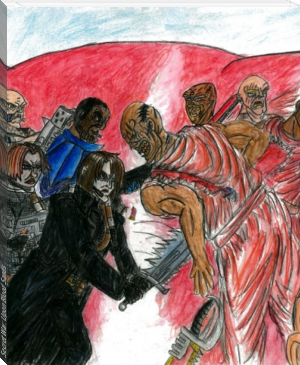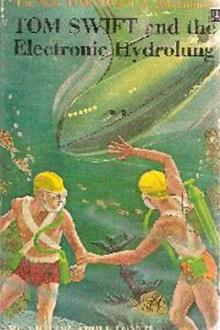Titan's Plague: The Trial, Tom Briggs [free ebook reader .TXT] 📗

- Author: Tom Briggs
- Performer: -
Book online «Titan's Plague: The Trial, Tom Briggs [free ebook reader .TXT] 📗». Author Tom Briggs
Her half-a-meter-high NDT robot disembarked from the back of the bus and rolled toward Pati. The bus drove down a short distance and turned around about the time the robot stopped in front of her. Pati looked to see the four lights on the robot’s control panel were green, and she pushed the button next to those lights to start it working.
The bus passed behind her, and she followed the robot to the wall about ten meters from the road. This section of Karakorum looked like a monster drinking can dug into the ground. She knew it was a hundred meters to the top and a thousand meters to the other side. The robot crawled onto the wall and slowly climbed. It made no sound, which actually would carry better on Titan than on Earth. Except anyone outside to hear that sound would also be wearing a helmet.
Pati backed up to get a better view of the robot, testing the thickness of the hull using ultrasound as it went. After ten minutes, it reached the top of this section of Karakorum. Then, the robot shifted over its one-meter width and crawled back down, repeating the process. To her left was the twenty-two meters remaining to be completed before lunch. The old term, “watching paint dry,” came to mind. And although she never painted, or knew someone who did, she could now understand the meaning.
Two hours later, not only was she bored, but she was getting a headache. The robot was half done, right on schedule; Pati, however, was wondering how much more of this she could take. She rubbed her helmet instead of rubbing her head, which provided no relief.
Pati then remembered she had a water tube for hydration in her helmet. She turned her head and sucked in a liter of water. Her helmet displayed the amount, telling her there remained another liter to drink. She also had two pain-killing tablets placed within reach of her mouth. These, she took, and hoped they would work.
Next to the oxygen cartridge hung the rebreather control board. She pulled this up and saw her battery was nearly at full charge. There was also almost a full cartridge of oxygen remaining. The third parameter measured by the control board was her CO2 level, and it showed twenty-times the safe level. According to Dr. Smith’s lectures, that meant her rebreather wasn’t rebreathing.
Pati hit the emergency button on the control board, and a red light illuminated in her helmet display. A response was displayed with a ten-minute estimated time of arrival.
“Ten minutes!” she shouted into her helmet. She keyed her microphone and called her boss.
“Larry here,” he replied.
“Larry, this is Pati. I think my rebreather stopped working, and the emergency response says it’ll take ten minutes to get here.”
She heard him sigh on the other end. “Okay, let me check your stats,” he said. She waited fifteen seconds according to her display, which felt like a year at the moment. “All right,” he said, “uh, Pati, it seems like your CO2 level is about 12,000 ppm, which isn’t good, but you won’t die anytime soon either. Don’t worry about the ten minutes.”
“My head is killing me, Larry.”
“Bleed a little more liquid oxygen into the line.”
She complied by squeezing a valve fastened to the small cartridge, but she didn’t feel any better. Her head hurt, and the pickup was still eight minutes away. When she went outside her mining ship, she knew a malfunction in her respirator would mean immediate death. These people didn’t think immediate death was a critical situation, at least not for a new hire.
“It’s not working,” Pati said.
“It’ll take a few minutes. Try to calm down because you’re raising your CO2 levels faster than normal. I’ll see you when you return.” He signed off.
She tried to calm down, except the sound of her breathing filled the inside of her helmet, and her breathing rate increased, which would hasten her death. She tried again to calm down and bled a little more of the liquid oxygen into the line. This time she noticed a difference. She had to think about her situation.
First, this wasn’t out in space, and she wasn’t in a vacuum. That meant instant death was less likely. There was an atmosphere of nitrogen all around her, and all it lacked to be breathable was a fraction of oxygen in it. Could she exhaust her helmet while holding her breath? Then she could let nitrogen from the atmosphere refill her helmet and add oxygen from the cartridge. That might get her to the breathable point.
There were six minutes left. She checked her CO2 level, and it was up to 13,000ppm. The liquid oxygen was not working other than relieving her headache a little. Why wasn’t it reducing the CO2?
The robot went about its duties as if nothing was wrong. It would probably finish on time and be ready for pickup even if Pati was lying dead next to the road. She wondered if there were any emergency supplies on it, except it was working its way up the wall. By the time it returned to ground, the emergency response would already be here.
“What the hell,” she said. She slipped the pack with the rebreather off her back, without disconnecting the tubes to her helmet. The tubes were long enough and she sat the pack on the hardened road in front of her after she sat down. The nearest streetlamp was at least thirty meters away on each side. Not enough to illuminate what she needed to see, so she pulled out her flashlight to see through the hazy night.
First, she checked her connections as Dr. Smith had taught her. Each tube was firmly connected, so nothing there. The battery still had a good charge, and even through the insulated glove, she could feel the pump running. The arrow on the scrubber pointed in the right direction. What else could it be?
The checks took at least four minutes of time she could have spent worrying about her mortality, and she decided keeping busy for the last two would be a good plan. After strapping the rebreather back on, she checked the valves in her helmet. She pulled a release valve, which she found did nothing because the atmospheres were equalized. She blew hard into her helmet while pulling the release valve again so she could exhaust some bad air. Then she bled more oxygen.
The CO2 monitor showed no improvement. She thought about bleeding more oxygen but wasn’t sure if there was a downside to that or not. Why couldn’t they just give her a normal respirator like in space? All Dr. Smith could go on about was how much easier and simpler the rebreather was compared to carrying air with you.
Pati believed easier and simpler was something you turned on and forgot about. Not something that gave you a headache the first time you used it. She looked back at the robot; it was still going about its business.
Finally, she saw the emergency pickup tooling down the road from the same direction she’d been dropped off from. It had the same rectangular shape as the bus she rode out on, although about half as long. This one had a driver that she could see through windows that went all around the upper half of the vehicle. The driver stopped in front of her and opened the right-side door.
It wasn’t airlocked, and he waved her to get in, which she didn’t hesitate. She assumed the atmosphere in the emergency vehicle was breathable, considering the driver had no helmet on, so she took hers off.
“What’s the problem, Lynch?” the driver asked. He was of some Asian descent and looked tall enough to have been born on Titan. He wore the same insulated suit as Pati did without the gloves, which probably allowed him to control his bus better. He sat before a dashboard with buttons and gages, although the traditional steering wheel was missing.
“My CO2 level went sky high,” she said.
“How high?”
She pulled her control board up to see. “It’s 12,000 ppm right now.”
“That’s it?”
“You want to try breathing it.”
“Not like it’s poisonous or anything. But I bet your scrubber stopped working. Where’s your robot?”
“It’s on the roof, testing the metal. Why?”
“Because we can’t leave it by itself. Where’s your laser pointer?”
“Uh,” she said. She wanted to ask what that was but felt stupid enough already.
“You don’t know where your laser pointer is, do you?”
“No, I, well, they didn’t give me one this morning,” she said. Then she came clean. “What does it do?”
“It controls your robot from the ground. That way, we don’t have to wait hours before taking it in.” He reached into a drawer under his dashboard, pulled out what could easily be a laser pointer, and stood up. “Wait here,” he said.
“I don’t expect to be going anywhere,” she said, under her breath, and watched the driver pull gloves from another drawer. He stood up and walked out the doors Pati had walked in through. She looked back and saw a helmet sitting on the other side of his chair, right as he entered the atmosphere of Titan without it.
The doors stayed open, and he didn’t go far, just enough to point the laser at the robot and push a few buttons. About five seconds later, he returned to the bus with the doors shutting behind him.
“How did you do that?” Pati had to ask.
He looked her up and down, “You’re from Earth?”
“Yeah.”
“I’ve got a lotion I put on my face to help with the cold, even though I probably don’t need it anymore. When I get out there, I just hold my breath and squint my eyes. That quickly, the cold doesn’t affect you, although you still have to show some respect.”
Pati shook her head as he walked





Comments (0)